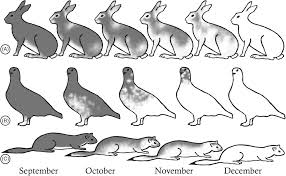For my first sketch exploring the theme of time, I chose to look into using nature as cues to the progression of the seasons and time. Over the summer, I had my shoulder re-replaced and spent a lot of time watching TV while I recovered. I was watching an episode of season 7 of Alone on the History Channel, which followed 10 survivalist contestants as they competed to outlast each other in the Arctic, when I saw something that caught my attention.

I was struck by one of the contestants commenting that she knew winter was near because the rabbits around her camp were turning white. Then, on the screen, a nature fact appeared indicating that these rabbits—snowshoe hares, I believe—change colors due to a receptor that senses when the daylight hours were growing shorter as winter approaches. I don’t know why that made such an impression on me, but I appreciated that, not too unlike navigating by the stars, for a long time and likely across many cultures in similar regions, this complex biological response has been used as an indicator of the passage of time, even when not fully understood.

I created this sketch as a thoughtful activity to visualize the changes in time, seasons, and appearance of the snowshoe hare. I found open-licensed images online for the rabbit and sun. I created the rest of the images using Procreate and then formatting them in Photoshop. If you’re interested in checking out the clunky code I used, take a look here for my “The Snowshoe Hare’s Timeless Coat” p5.js sketch. I will confess, I hadn’t done a complete sketch in p5 in many months, so I spent a while getting my bearings. That said, a good deal of my time was spent working to create the images and reformatting them so p5 wouldn’t do weird stuff. (I kept getting a lot of lag and color distortions.)

When you interact with this sketch, you’ll start at the beginning of the year in the Arctic—January, when the daylight is scarce, snow is on the ground and the snowshoe hare is blended into the surrounding environment. As you move the slider through the year, you’ll see more light, the snow melt away, and the snowshoe hare, once again, blend into its surroundings before returning to white when winter returns.
Here’s a direct link to my sketch The Snowshoe Hare’s Timeless Coat on p5js
I also wanted to learn more about this phenomenon. So here are a few of the most interesting facts I picked up along the way:
- Snowshoe hares have a snow-white winter coat that turns brown when the snow melts each spring. It takes about ten weeks for the coat to completely change color.
- According to the Alaska Department of Fish and Game, “Daylight, not cold weather, triggers seasonal shedding and hair growth. Animals register changes in the photoperiod – the hours of daylight – which spurs the secretion of hormones such as prolactin and melatonin.”
- When threatened, rabbits typically freeze and rely on camouflage, as compared to hares, who use their big feet to flee at the first sign of danger. Rabbits are born blind and helpless, while hares are born fully furred and ready to run.
- Climate change means snowshoe hares stands out like lightbulbs against a snowless background.





